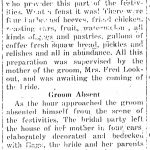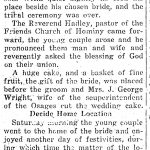May 29, 1927
The Daily Journal Capital
Microfilm Roll: MN00273
On this day in Osage country, The Daily Journal-Capital published an article describing the wedding ceremony of Dora McCarthy and Henry Lookout, the youngest son of Chief Fred Lookout.
The wedding of McCarthy and Lookout seems to have been commemorated using a mix of old and new traditions. The article states that the couple was married “by the law of the land,” but that the celebration did not end there, for even the “royal strain of chieftain must observe the established tribal ceremony.”
According to traditional Osage marriage customs, once an adolescent reached the age of puberty, they were ready for marriage. This form of marriage, one between two never-before-married adolescents, was called Me Shin. Rather than allowing two children to select their future spouses, the groom’s family carefully chose the bride for him; however, it seems as though the family would take the groom’s opinion into consideration. The family’s choice then had to be approved by four elders who had been given the appellation of Ne ka To ho, or “good men” (Burns, 76). This specific title was only given to men who were married through traditional Osage customs and whose family then followed that example for at least three generations. Once the bride was chosen and approved, gifts were bestowed upon the bride’s family, by means of a messenger, who were then to decide if they wanted to accept the offer. Gifts often included horses, or later cars, blankets, sometimes food, etc. At least one gift was expected to be given to each and every close relative of the bride. The bride’s family also consulted with the four Ne ka To ho about the groom’s family before making a final decision. If the bride’s family chose to accept the proposal, they would then send the messenger to the groom’s family with their response. A day later the bride’s family would send the bride, along with gifts, to the groom’s home. A silent manner of saying “We give to you our daughter” (La Flesche, 129 ). The morning after, the couple was then sent back to the bride’s family, a silent response meaning, “We give to you our son.” Once this action was completed the traditional marriage, or Me shin, was complete.
If someone who was married once before was looking to remarry, the traditions were slightly different. This form of marriage was called the O me ho, or “those who have married before” (Burns, 77). As opposed to the complicated involvement of all parties, in this case if a man wished to marry, he would send gifts along with his proposal to the bride herself. Then the bride would forward the messenger to her parents, or other close relative, who would then send their response back to the groom. If the proposal was accepted, the groom would travel to the bride’s home and sit next to her. With this gesture, the couple was officially married.
There is a third form of marriage known as Ka shon le Me gro ka, or “those who have married recklessly,” which according to Osage customs was not accepted (Burns, 78). This was the case if a couple married through common law, or lived together, prior to their formal Me shin marriage. In such cases, the husband would never be given the honor of carrying the status of Ne ka To ho, nor would the future children of such marriage ever bear a clan name.
Morgan M. Guzman
“Tribal Ceremony Ends Festivities of Osage Wedding.” The Daily Journal-Capital. May 29, 1927, p. 1 & 7. Microfilm roll number MN00273. Sequoyah National Research Center, Little Rock, Arkansas.
Further Reading
Burns, Louis F. Osage Indian Customs and Myths. Tuscaloosa: University of Alabama Press, 2005.
La Flesche, Francis. “Osage Marriage Customs.” American Anthropologist 14, no. 1 (1912): 127-130.
“Osage Weddings Project.” Sam Noble Museum. https://osageweddings.com/ Date accessed May 22, 2018.
Source File(s)
Related Stories
- Osages Begin Dances Today in Advance of Oct. 14 Celebration
- The Burial of Nellie Saucy Chief
- Indians Plead for Right to have Peyote

